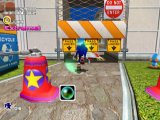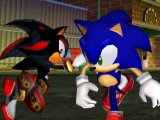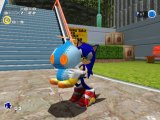Sonic Adventure 2 Review
For Dreamcast
Rating: Average
Sonic Adventure 2 represents everything that is wrong with Sega as a
developer. Far too often, the company releases games that have some degree
of potential, but never come close to realizing it because the games are too
short or shallow. These games include Crazy Taxi, Jet Grind Radio,
Outtrigger, Sonic Adventure 1, Virtua Striker, World Series Baseball 2001,
and Space Channel 5. When Sega tried to make an ambitious game with some
real depth (Shenmue), it failed in its attempt, and the game was a
disappointment both critically and commercially.
Sonic Adventure 2 is the latest piece of evidence that Sega as a company
still has the mindset of an arcade game developer that is not obligated to
keep anyone entertained for more than three to five minutes at a time.
Sonic Adventure 2 is also further proof that more and more respected
companies are willingly bastardizing their game franchises in order to
appeal to the mass market, which makes up 80 percent of the population but
only 20 percent of the game industry's revenue.
The focus of the game this time is not on aimless exploration, but on the
story line. Nintendo's Shigeru Miyamoto has made countless great games in
his time, but he doesn't know the first thing about writing a good story,
and neither does fellow "game design legend" Yuji Naka. What's really
puzzling is not so much that the plot sucks (which is to be expected), but
the fact that such a heavy emphasis is placed on the plot throughout the
entire game.
If Yuji Naka is such a game development genius, why would he allow such a
strong focus to be placed on a story line that is this ridiculously bad?
It's one thing to give a game a bad story, but it's another thing altogether
to do so and then make the story the centerpiece of the game. The
characters are all simple stereotypes whose individual personalities can be
described in just a few words.
The story is made even less bearable by the voice acting, which was
clearly done by so-called actors who were deemed unqualified to make semi-
erotic grunts in Mario Party. In particular, the voice actor who portrayed
Shadow (the evil hedgehog) is about as convincing as my impersonation of
Comedy Central's Jiminy Glick-- and that's not a good thing.
At times, it seems as if the people who were in charge of writing the
dialogue arrived at Sega's offices, wrote a few lines, and then called it a
day of work (or in this case, a two-year development cycle of work). How
else can you explain the fact that every time Shadow says something, it's a
slight variation of the line, "There's no time for games!" It's hard to
believe that none of the dialogue writers ever said, "Wait a minute, we
already used that line in all of Shadow's previous scenes... maybe we should
think of something new for him to say."
SA2's exploration levels are just as tedious as they were in SA1, only
now there are less of them. This welcome change is counter-balanced by the
fact that the action sequences are even more mindless than they were in SA1.
Many of the action sequences can barely qualify as "interactive
entertainment."
If you hold a direction on the analog stick and keep it held down for a
long period of time, the game will complete the task of getting to the end
of the level for you. In the slightly modified words of Mr. T, "I pity the
fool who had to create all of these intricate environments, only to have the
player zoom past them with no skill required other than the fine art of
holding forward on the analog stick."
If the action scenes don't leave you with a feeling of emptiness, Sega's
odd sense of morality just might. Sega is trying to sell gamers on the idea
that the game gives you a choice between good and evil, but this isn't
exactly Peter Molyneux's Black & White here, folks. In an era where knee-
jerk reactions are causing developers to drastically tone down the "evil"
acts in their games, Sega has been just as guilty as anyone else.
For proof, witness the "moral" inconsistencies that are apparent in Sonic
Adventure 2. You can throw an un-hatched Chao egg off a mountain to its
death, but trying to do the same thing to a hatched and living Chao creature
results in it bouncing off of an invisible wall and returning to safety.
Also, you can temporarily stun the little helper Chao's in a variety of ways,
but they always come flying back towards you rather than dying, as many
gamers will undoubtedly wish.
Even if Sega's inconsistent sense of morality hadn't reared its ugly head
in Sonic Adventure 2, it would be still be a fair statement that the
gameplay has been neutered in an attempt to appeal to the ever-elusive kids
market. This game won't be much of a challenge for anyone who was alive
when the first Sonic game was released 10 years ago. In addition, some
parts of the game (like the Chao races) seem to exist only to keep the six-
and-under crowd entertained.
Like the gameplay, the music seems to get worse with each new Sonic game.
The embarrassingly bad lyrics have the capability of making even small
children groan and cover their ears in horror. Worse yet are the stages in
which the music seems to be trying its best to be "hip" (such as the lame
rap songs that accompany Knuckles). These stages only serve to expose the
fact that Sega of Japan knows nothing about what is considered decent music
in America (and no, J-Pop that loops every six seconds doesn't count either).
After years of searching for the solution to the camera problems that
have always plagued third-person action games, Sega seems to have come up
with the following conclusion: There is no solution! The instruction manual
says that the camera can be freely manipulated by using the L and R buttons,
so why is it that every single time I try to do so, the game decides to
quickly move the camera back to where it was before I tried to move it?
Any remaining semblance of Sonic being a cool mascot character with
attitude was thrown out the door when Sega unleashed this cookie-cutter
sequel on the unsuspecting public. Sega's outdated reputation as an
innovative and edgy company seems to be fading away with each passing month
and year, and games like Sonic Adventure 2 do nothing to reverse this trend.
Send your thoughts on this review to ivan@mastergamer.com



 Back To Reviews
Back To Reviews


© 2001, ivan@mastergamer.com



 Back To Reviews
Back To Reviews




Back To Reviews
